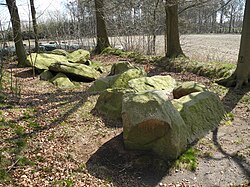Restrup passage grave
| Restrup passage grave | ||
|---|---|---|
|
|
||
| Coordinates | 52 ° 34 '28.4 " N , 7 ° 46' 29.8" E | |
| place | Eggermühlen , Lower Saxony , Germany | |
| Emergence | 3500 to 2800 BC Chr. | |
| Sprockhoff no. | 886 | |
The passage grave of Restrup is a Neolithic large stone grave with the Sprockhoff no. 886. It originated between 3500 and 2800 BC. BC as a megalithic system of the funnel beaker culture (TBK). Neolithic monuments are an expression of the culture and ideology of Neolithic societies. Their origin and function are considered to be the hallmarks of social development.
The large stone grave is located southeast of the Restrup farm group in a group of trees, about two kilometers northwest of the Eggermühlen district of Döthen, near the L73 (Bippener Str.), In the joint municipality of Bersenbrück in the Osnabrück district in Lower Saxony . There is also a cup stone that has been moved here , which is referred to here as a “cup stone”. The square wall around the grave is modern.
The passage grave
It is an east-west oriented, relatively well-preserved Emsland chamber, about nine meters long, with no remains of an enclosure. The chamber is quite deep in the burial mound. Two of the original 14 supporting stones are missing. Of the original five capstones, one is missing, one is broken, another is only half preserved and shows clear traces of an attempt to split it. The clear width of the chamber is around 1.8 meters at the outer ends and two meters in the middle. The bearing stones of the middle and largest capstone (in the access area) protrude so far from the phalanx that three areas of different widths are formed inside. The northern long side is slightly curved inwards. The entrance from which no stones have been preserved is on the south side.
The cup stone
The "Teufelsstein" or "Deuvelstein" is right next to the megalithic complex. The boulder is a 1.75 meter long, 1.15 meter wide and 1.1 meter high granite block . It got its name from legends that brought it in connection with the devil, who pressed the bowls into the stone with his thumb and is said to be responsible for a larger breaking point. It has 66 bowls on its curved surface. As with all cup stones, the purpose of the indentations located on one of the vertical sides of this stone is unknown.
It escaped destruction by chance and was scientifically examined by Walter Nowothnig (1903–1971) in 1956 . It is one of the rare cases in which archaeological findings have been made on a cup stone . It turned out that the stone was processed to create a sufficient base. Under him, flint , charcoal and broken bones were found broken by heat , the anthropological investigation of which could not clarify whether it was human or animal remains. After the investigation, the shell stone, originally found a little south of Restrup, was moved to its current location.
See also
- Nordic megalithic architecture
- The complex is on the street of the megalithic culture
literature
- Anette Bußmann : Stone Age witnesses. Travel to the prehistory of northwest Germany. Isensee Verlag, Oldenburg 2009, ISBN 978-3-89995-619-1 , pp. 48-49.
- Mamoun Fansa : large stone graves between Weser and Ems . Isensee Verlag, Oldenburg 1992, ISBN 3-89442-118-5 , pp. 84-85.
- Ernst Sprockhoff : Atlas of the megalithic tombs Germany. Part 3: Lower Saxony - Westphalia. Rudolf Habelt Verlag, Bonn 1975, ISBN 3-7749-1326-9 , p. 114.
Web links
- The Megalithic Portal: Restruping large stone grave
- strahlen.org : Large stone grave "Bippen" ("Restruper stones"), Restrup at Bippen
- steinzeugen.de: Restrup large stone grave
- cruptorix.nl: Bippen
Individual evidence
- ↑ J. Müller In: Varia neolithica VI 2009 p. 15


